The Viking blót sacrifices
It was always important for the Vikings to be on good terms with the gods. In order to ensure that this was the case they made “blót” sacrifices. The blót was an exchange, in which they sacrificed to the gods in order to get something back in return. For example, this might the gods’ goodwill regarding weather, fertility or luck in battle.
Viking names in the landscape today
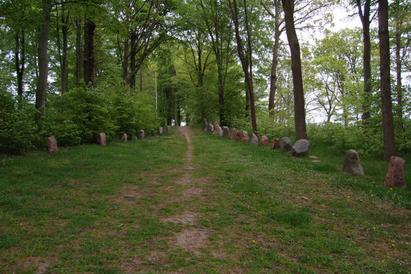
Old place names can indicate which gods were worshipped in certain geographical areas. For example, Tissø in West Zealand and Tyrseng at Viby in Jutland, are named after the god Týr. Týr was the god of war, but also god of the assembly or “ting”, where legal proceedings and meetings were held. Therefore Tyrseng may have been a location for assemblies.
There are also places in Denmark which are named after Odin. The Vikings did not use Odin’s name indiscriminately. It was reserved for places of special significance. Onsholt in Aarhus is one such place. Onsholt is a shortening of Odin’s Holt, which means ”Odin’s Wood”. We know from written sources that the Odin cult demanded human and animal sacrifices. Both animals and people may have been hung at Onsholt. Odin was the god of the upper classes and was primarily worshipped by magnates and warriors.
Another example is Odense, which means Odin’s Vi. The word ”vi” appears in many place names and means shrine. The Vikings called special consecrated areas “vier”. Here sacrifices were offered to the gods in natural surroundings. The word ”vi” is still used in Danish and means to make something holy. It forms part of the Danish words “vielse” (marriage or wedding) and “indvi” (christen, consecrate or ordain).
Magnates’ residences in Scandinavia
Magnates’ residences with cult buildings and sacrificial areas have been found at several locations in Scandinavia. These include: Tissø, Lejre and Toftegård on Zealand; Gudme on Funen; Sorte Muld on Bornholm; Lisbjerg Church and Erritsø in Jutland; together with Uppåkra and Järrestad in Scania, Sweden.
Magnates in charge of celebrations
Control of the cult was important. Evidence suggests that local magnates were in charge of the large religious celebrations on their impressive estates. Archaeological excavations have provided evidence that the great estates were once political, economic and religious centres.
Various forms of rituals were presumably practised on small farms, but the larger ceremonies took place at the magnates’ residences. Here the farmers of the area met on certain occasions to worship the gods in a great sacrifice known as a “blót”. At the great blót celebrations the local magnate functioned as a ”Gode” (pagan priest) – the practitioner of the cult.
The blót feasts were also a way in which the magnate could display his wealth and power, for instance, by supplying food and drink to all. With the introduction of Christianity, religious power was transferred to the Church and these blót feasts lost their significance.
Sigurd Håkonsson’s blót
One of the most comprehensive descriptions of a blót sacrifice in the North can be found in Hakon the Good’s Saga, which was written by the Icelander Snorri Sturluson in the 1200s.
Sigurd Håkonsson, like his father, frequently made sacrifices. It was the common practice that all farmers from the area gathered at the temple to sacrifice. All were given food throughout the celebration.
Many different animals were sacrificed, especially horses. The blood from the sacrificed animals was collected in bowls and twigs were used to spatter the blood on altars, walls and cult participants. The meat was cooked and then eaten by all in attendance. It was boiled in cauldrons that hung over a fire in the middle of the hall. Full cups of beer were carried around the fire and the magnate, who was the pagan priest, then blessed the meat and the cups.
Toasts were then made. The first was in honour of Odin, “to the king and victory”. Afterwards the cups were emptied for Njörd and Frej in the hope of securing a prosperous and peaceful future. Then the participants emptied their cups with a personal pledge to undertake great exploits, in battle, for example. Finally toasts were made for kinsmen resting in burial mounds.
Snorri writes that Sigurd Håkonsson was a very generous man and supplied the whole feast, which he was long remembered for.
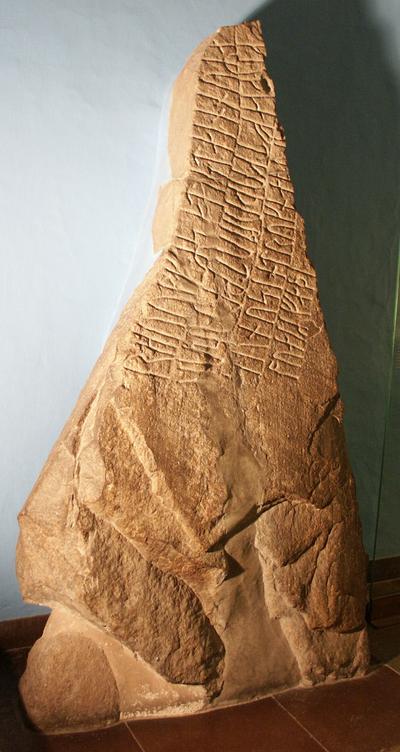
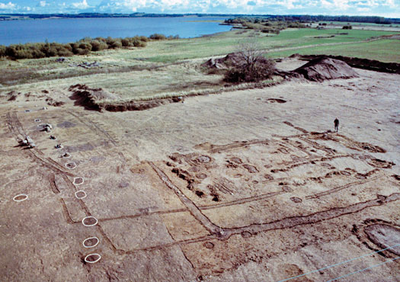
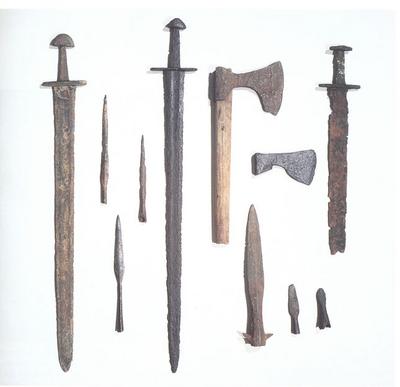
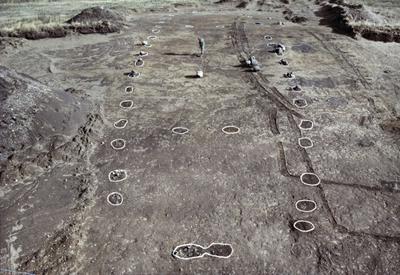
The sacrificial rituals of the Vikings
The sacrificial rituals of the Vikings ranged from great festivals in magnate’s halls to offerings of weapons, jewellery and tools in lakes. Humans and animals were also hung from the trees in holy groves, according to written sources. The Vikings repeatedly used certain sacrificial sites, because they believed that there was particularly strong contact with the gods at these locations. From the accounts of the Christian missionaries we know that the Vikings sacrificed to statues, which stood out in natural surroundings or in cult buildings.
It is believed that there were four fixed blót sacrifices a year at the following times: winter solstice, spring equinox, summer solstice and autumn equinox. The Vikings also held additional blót sacrifices, for example, if a crisis arose that required help from the gods.
The Arabic traveller al-Tartuchi describes how the Viking town of Hedeby celebrated the winter solstice. “They celebrate a festival, at which all come to worship the god and to eat and drink. The one who slaughters a sacrificial animal erects stakes at the entrance to his farmyard and puts the sacrificial animal on them. This is so that people know that he is sacrificing in honour of his god.” The sacrifices might be followed by a communal blót feast – a feast at which the participants ate and drank together. Sacrifices of animals were not the norm, but were primarily associated with magnates and kings.
Cult specialists
Cult specialists were closely connected to the gods. The sagas and archaeological finds show that völur or seeresses existed. These were women with magical and prophetic powers. In the sagas and on rune stones great men are also mentioned known as “Goder”, or heathen priests, who functioned as cult leaders. Therefore both men and women could be specialists in cultic activities.
The runic inscription on the stone from Helnæs mentions the Viking pagan priest, the “gode” Roulv (Hróðulfr), who is also mentioned on other rune stones in the southern part of Funen. The inscription dates to the 700s or 800s. When it was found the stone split into several pieces and the upper part is missing. The rune stone was brought to Copenhagen at the request of King Frederik VII.
Hróðulfr, {nuRa}-priest/chief, placed the stone in memory of Guðmundr, his nephew. They drowned ... Ávarr coloured.
Tissø – a magnate’s residence used for rituals
Archaeologists have discovered an impressive Viking magnate’s residence at Tissø, in West Zealand, with an associated market place and several cult sites located in the surrounding landscape. When the market was held, the magnate’s residence was an important meeting place, and could host significant religious celebrations and sacrifices. The residence belonged to a magnate, or perhaps even the king.
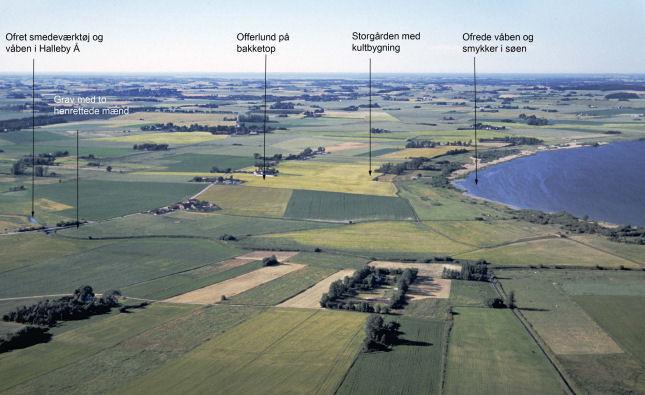
The magnate’s residence
The residence included a great hall and a small enclosed area with a cult building. Cult activities were performed in this small building, and statues of gods and cult objects may have been kept here.
Numerous animal bones and fragments of drinking glass have been found in the great hall. This indicates that great feasts were held here. A large pile of stones, which had been subjected to heat, was located outside the hall. The stones may have been used in connection with ritual feasts and sacrificial activities in the hall.
A ritual landscape
Several cult sites, which have produced evidence of ritual activity, have also been found in the landscape surrounding the magnate’s home.
Weapons and jewellery were recovered from the lake known as Tissø (meaning ' Týr’s lake'). They were thrown into the lake at some point during the Viking period. Týr was the Viking god of war and the numerous swords, lances and axes were probably an offering to him. Weapons and smith’s tools have also been found nearby, at the Viking bridge over the River Halleby. The smith was highly regarded in Viking society and his work was considered as holy.
On a hilltop a few hundred metres from the magnate’s residence, another sacrificial site has been excavated. This was an open “hørg”. A thick layer of animal bones was found, which has been interpreted as the remnants of ritual feasts. Offerings of silver objects, coins, jewellery and tools were also recovered on the hill.
The Viking cult activities at the magnate’s residence and in the surrounding area at Tissø display great variations. At least four different sacrificial sites were used simultaneously. The cult site that was used and the nature of the offerings may have depended upon the time of year and on which gods were being sacrificed to. The offerings on the hilltop may have taken place at the summer solstice on the 21 June, whilst the great hall (“hovet”) was probably used for sacrifices at the winter solstice on 21 December.
New times
For almost 500 years, from 550 AD onwards, the magnate’s residence functioned as the centre of the pre-Christian cult in the Tissø area. Around 1000 AD the pre-Christian cult structures were apparently demolished and taken down. They were replaced by a small Christian chapel or church - a square stave building measuring only 7 x 7 m. This was probably one of the first private churches in Denmark. Sacrificial activities also ceased at the cult sites in the surrounding landscape around this date. Time was running out for the Norse gods and Christ was ready to replace them.
